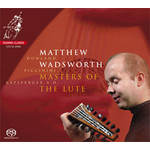
Masters of the Lute
 $43.00
Out of Stock
$43.00
Out of Stock6+ weeks add to cart
JOHN DOWLAND / GIOVANNI KAPSBERGER
Masters of the Lute
Matthew Wadsworth (lute)
[ Channel Classics SACD / SACD ]
Release Date: Friday 15 December 2006
This item is currently out of stock. It may take 6 or more weeks to obtain from when you place your order as this is a specialist product.
"A rich recital that travels from melancholy to sunlight...and back again. One hopes that any new lute lovers will proceed apace to Matthew Wadsworth's gem of an album, which exudes intelligence, sensitivity and sheer class." Editor's Choice Gramophone Magazine (Dec 2006)
Hybrid/SACD - playable on all compact disc players
Editor's Choice Gramophone Magazine (Dec 2006)
"A rich recital that travels from melancholy to sunlight...and back again. One hopes that any new lute lovers will proceed apace to Matthew Wadsworth's gem of an album, which exudes intelligence, sensitivity and sheer class." (Gramophone)
John Dowland (1563-1626) was one of England's greatest composers and lutenists, as well as a ground-breaking innovator. It was Dowland who effectively created the English lute-song, imaginatively drawing together elements from the broadside ballad, dance music, consort song and madrigal. He is famous for his passionate and almost obsessive melancholy which is never far away in his music, with sleep and death being sought as a release from earthly woes. Although clearly an affectation of the time, it was one which drew an acutely personal response from Dowland. He produced four marvelous books of songs and ayres, as well as over 100 solo pieces. The solos include virtually every form used by lutenists at the time: fantasies, dance movements (most notably, pavans and galliards) ballad tunes and sets of variations. In our own day, Dowland's music is very much thought of as being fresh and inventive, yet in his preface to A Pilgrime's Solace (1612) he mentions that his contemporaries thought otherwise. Although his music was admired throughout Europe for its tunefulness, dark melancholy and chromaticism, Dowland was still using older forms of composition, rather than the more fashionable lighter dances which were in vogue at the time. His pavans are written in an imitative style, found in consort music, which is so very different from the bass-driven harmonic textures of the younger generation such as Robert Johnson and Daniel Bacheler. Of the six pieces which begin this record, 'Lachrimae Pavin' and 'The Earl of Essex Galliard' also appear in Dowland's books of songs: Lachrimae Pavin as the song, 'Flow my teares' (Book Two, 1600), and the Earl of Essex Galliard as 'Can she excuse my wrongs' (Book One, 1597).
Tracks:
JOHN DOWLAND:
1 Preludium
2 Forlorn Hope Fancy
3 Lachrimae Pavin
4 Lachrimae Galliard
5. My Lord Willoughby's Welcome Home
6 The Right Honourable Robert, Earl of Essex, His Galliard 7. Greensleeves - Francis Cutting (d1596)
GIOVANNI GIERALOMO KAPSBERGER:
8 Toccata Arpeggiata
9 Kapsberger (by Kapsberger) Alessandro Piccinini (1566-1638)
10 Toccata X
11 Chiaconna in partite variate Robert de Visée (c1655-c1732)
12 Prélude
13 Allemande
14 Courante
15 Sarabande
16 Gigue
17 Chaconne des Harlequins
HEINRICH IGNAZ FRANZ von BIBER:
18 Passacaglia (arr. Karle Fischer)
